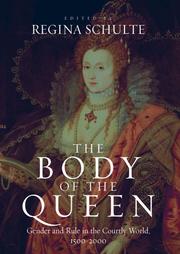| Listing 1 - 4 of 4 |
Sort by
|
Book
ISBN: 9788883345463 8883345460 Year: 2011 Volume: 125 Publisher: Roma Viella
Abstract | Keywords | Export | Availability | Bookmark
 Loading...
Loading...Choose an application
- Reference Manager
- EndNote
- RefWorks (Direct export to RefWorks)
Women
---
Femmes
---
Books and reading
---
History
---
Livres et lecture
---
Histoire
---
094.1 <45>
---
094 "15/16"
---
028-055.2
---
Oude drukken: bibliografie--
Book
ISBN: 9781003081395 9780367533212 9780367533229 Year: 2021 Publisher: London Routledge
Abstract | Keywords | Export | Availability | Bookmark
 Loading...
Loading...Choose an application
- Reference Manager
- EndNote
- RefWorks (Direct export to RefWorks)
In early modern times, religious affiliation was often communicated through bodily practices. Despite various attempts at definition, these practices remained extremely fluid and lent themselves to individual appropriation and to evasion of church and state control. Because bodily practices prompted much debate, they serve as a useful starting point for examining denominational divisions, allowing scholars to explore the actions of smaller and more radical divergent groups. The focus on bodies and conflicts over bodily practices are the starting point for the contributors to this volume who depart from established national and denominational historiographies to probe the often-ambiguous phenomena occurring at the interstices of confessional boundaries. In this way, the authors examine a variety of religious living conditions, socio-cultural groups, and spiritual networks of early modern Europe and the Americas. The cases gathered here skillfully demonstrate the diverse ways in which regional and local differences affected the interpretation of bodily signs.

ISBN: 184545121X 1845451597 1782386270 Year: 2006 Publisher: New York, N.Y. Berghahn Books
Abstract | Keywords | Export | Availability | Bookmark
 Loading...
Loading...Choose an application
- Reference Manager
- EndNote
- RefWorks (Direct export to RefWorks)
How many “bodies” does a queen have? What is the significance of multiple “bodies”? How has the gendered body been constructed and perceived within the context of the European courts during the course of the past five centuries? These are some of the questions addressed in this anthology, a contribution to the ongoing debate provoked by Ernst H. Kantorowicz in his seminal work from 1957, The King’s Two Bodies. On the basis of both textual self-presentations and visual representations a gradual transformation of the queen appears: A sacred/providential figure in medieval and early modern period, an ideal bourgeois wife during the late-18th and 19th Centuries, and a star-like (re-) presentation of royalty during the past century. Twentieth-century mass media has produced the celebrity and film star queens personified by the contested and enigmatic Nefertiti of ancient Egypt, the mysterious Elizabeth (Sisi) of Austria, Grace Kelly as Queen of both Hollywood and Monaco and Romy Schneider as the invented Empress.
Body, Human --- Courts and courtiers --- Human body --- Queens --- Sex role --- Social aspects. --- History. --- History of civilization --- History of Europe --- anno 1500-1799 --- anno 1800-1999 --- Court and courtiers --- Courtiers --- Kings and rulers --- Manners and customs --- Favorites, Royal --- Royalty --- Rulers --- Sovereigns --- Monarchy --- Women --- Empresses --- History --- Social aspects
Book

ISBN: 9791035104146 2859449868 9782859449865 Year: 2020 Publisher: Paris : Éditions de la Sorbonne,
Abstract | Keywords | Export | Availability | Bookmark
 Loading...
Loading...Choose an application
- Reference Manager
- EndNote
- RefWorks (Direct export to RefWorks)
Pourquoi conçoit-on des lieux fermés pour les hommes et d’autres pour les femmes ? En quoi les discours autour du genre ont-ils influencé l’émergence et la perpétuation de dispositifs de clôture pour affirmer les différences sociales entre hommes et femmes ? Quelles formes prennent les rapports entre les sexes dans les milieux clos ? Associant des approches historiques et sociologiques, cet ouvrage explore les interactions entre les différentes formes d’enfermements et le genre, ce qui induit une réflexion sur le féminin, sur le masculin et sur leurs interrelations dans les conditions créées par une séparation plus ou moins rigoureuse du monde. Les études de cas rassemblées dans ce volume entendent comprendre tant les effets que la clôture a produits et produit sur les conceptions du genre que, à l’inverse, les effets que le genre a produits et produit sur la clôture. Les rapports qu’entretiennent genre et enfermement sont envisagés sur la longue durée de l’histoire européenne, depuis les monastères médiévaux et les hôpitaux d’Ancien Régime jusqu’aux institutions pénitentiaires, bagnes et camps contemporains. L’ouvrage montre également leur résonance dans des territoires coloniaux d’Amérique et dans le monde chrétien de la Méditerranée orientale. Il révèle ainsi que les lieux clos sont des lieux matriciels où se sont élaborés et s’élaborent des pratiques, des techniques et des savoirs autour du féminin et du masculin.
Imprisonment - Europe - History - Congresses --- Enclosure (Monasticism) - History - Congresses --- Women prisoners --- Enclosure (Monasticism) --- Imprisonment --- Sex role --- Prisonnières --- Clôture (Monachisme) --- Emprisonnement --- Rôle selon le sexe --- History --- History. --- Histoire --- emprisonnement --- vie monastique --- relation homme-femme --- prisonnière
| Listing 1 - 4 of 4 |
Sort by
|

 Search
Search Feedback
Feedback About UniCat
About UniCat  Help
Help News
News